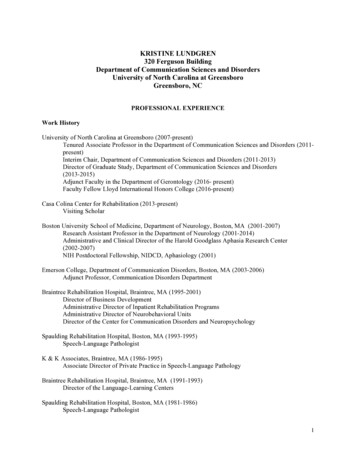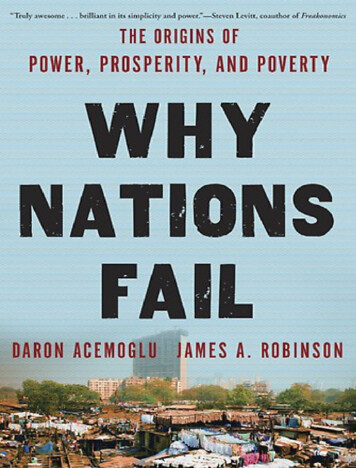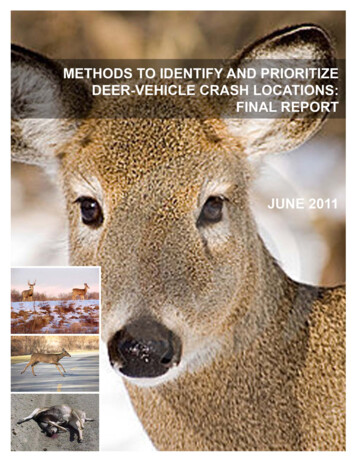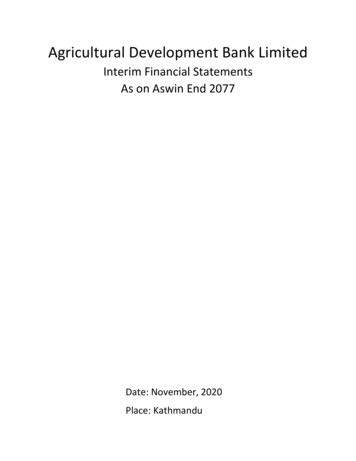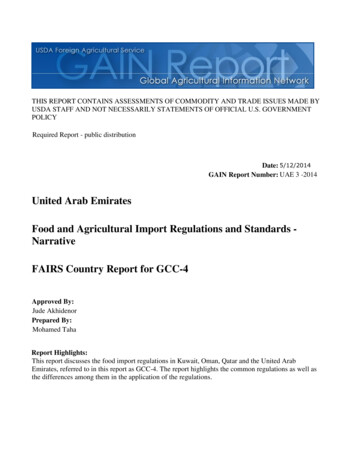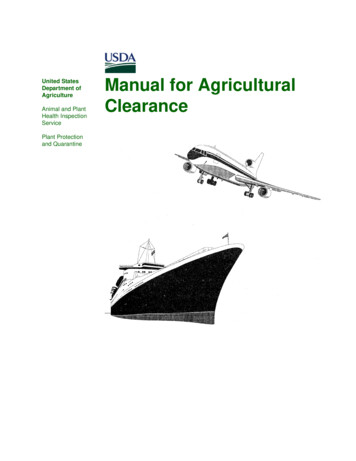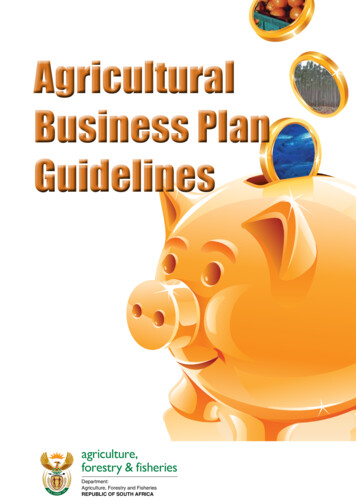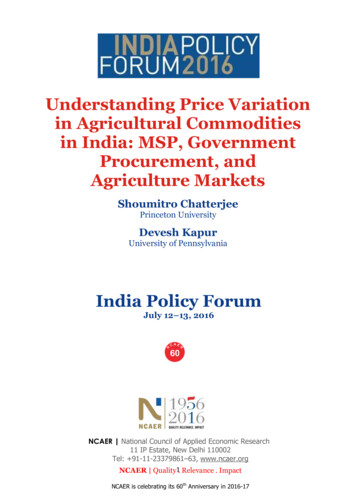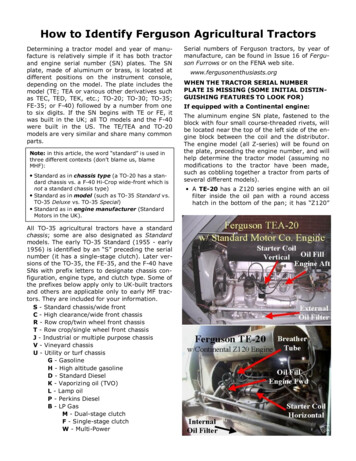
Transcription
How to Identify Ferguson Agricultural TractorsDetermining a tractor model and year of manufacture is relatively simple if it has both tractorand engine serial number (SN) plates. The SNplate, made of aluminum or brass, is located atdifferent positions on the instrument console,depending on the model. The plate includes themodel (TE; TEA or various other derivatives suchas TEC, TED, TEK, etc.; TO-20; TO-30; TO-35;FE-35; or F-40) followed by a number from oneto six digits. If the SN begins with TE or FE, itwas built in the UK; all TO models and the F-40were built in the US. The TE/TEA and TO-20models are very similar and share many commonparts.Note: in this article, the word “standard” is used inthree different contexts (don’t blame us, blameMHF): Standard as in chassis type (a TO-20 has a standard chassis vs. a F-40 Hi-Crop wide-front which isnot a standard chassis type) Standard as in model (such as TO-35 Standard vs.TO-35 Deluxe vs. TO-35 Special) Standard as in engine manufacturer (StandardMotors in the UK).All TO-35 agricultural tractors have a standardchassis; some are also designated as Standardmodels. The early TO-35 Standard (1955 - early1956) is identified by an “S” preceding the serialnumber (it has a single-stage clutch). Later versions of the TO-35, the FE-35, and the F-40 haveSNs with prefix letters to designate chassis configuration, engine type, and clutch type. Some ofthe prefixes below apply only to UK-built tractorsand others are applicable only to early MF tractors. They are included for your information.S - Standard chassis/wide frontC - High clearance/wide front chassisR - Row crop/twin wheel front chassisT - Row crop/single wheel front chassisJ - Industrial or multiple purpose chassisV - Vineyard chassisU - Utility or turf chassisG - GasolineH - High altitude gasolineD - Standard DieselK - Vaporizing oil (TVO)L - Lamp oilP - Perkins DieselB - LP GasM - Dual-stage clutchF - Single-stage clutchW - Multi-PowerSerial numbers of Ferguson tractors, by year ofmanufacture, can be found in Issue 16 of Ferguson Furrows or on the FENA web site.www.fergusonenthusiasts.orgWHEN THE TRACTOR SERIAL NUMBERPLATE IS MISSING (SOME INITIAL DISTINGUISHING FEATURES TO LOOK FOR)If equipped with a Continental engine:The aluminum engine SN plate, fastened to theblock with four small course-threaded rivets, willbe located near the top of the left side of the engine block between the coil and the distributor.The engine model (all Z-series) will be found onthe plate, preceding the engine number, and willhelp determine the tractor model (assuming nomodifications to the tractor have been made,such as cobbling together a tractor from parts ofseveral different models). A TE-20 has a Z120 series engine with an oilfilter inside the oil pan with a round accesshatch in the bottom of the pan; it has “Z120”
cast into the left side of the block and isequipped with Lucas electrical components; ithas two T-handle hood release levers underthe instrument console, one on either side;there is a rod on each side of the oil pan forextra support between the front axle carrierand the clutch housing; and the shift lever isbolted on to the transmission cover.bers are located between the oil filler and the coilon the left side of the engine. On Diesels thenumbers are just above the generator on theright side of the engine. A TEA has a gasoline engine whose SN beginswith “S” and ends with “E.” A SN of 1 through100204 indicates an 80mm (bore) engine. Engines from 100501 through 117000 are 85mmengines. Engines with SN SC1E - SC102519Eare later 85mm engines. Engines up toS112390E are 6V; engines from that point onare 12V with the air intake on the right side ofthe instrument console. Some late enginesmay have “EVR” as a suffix, indicating it hasrotating exhaust valves. A TEF has a Standard 20C Diesel engine with a“SA” prefix and an “E” suffix. A FE-35 gasoline model is equipped with a87mm Standard engine having a SN prefix of“SF.” However, various suffices were included:“EHS” (6.6:1 compression ratio with singlestage clutch)TE & TEA Identifying Features A TO-20 also has a Z120 series engine, but isequipped with Delco electrical components; itwill have one hood release lever under theinstrument console on the left side; and theshift lever knob is small and chromed.“EHD” (6.6:1 compression ratio with dualstage clutch)“ELS” (6.0:1 compression ratio with singleclutch - High Altitude above 5000 ft.)“ELD” (6.0:1 compression with dual clutchHigh Altitude above 5000 ft.) A TO-30 has a Z129 series engine with“Z129” cast into the left side of the block; ithas an external oil filter on the right side ofthe engine, horizontally positioned, and parallel to the engine; and has a larger, hardrubber shift lever knob. A TO-35 has a Z134 series engine with “Z134”cast into the left side of the block; the frontaxle is in three pieces and is angled, similar tothe TO-20/30; and steering arms and radiusrods to support the axles are found on bothsides of the tractor (in contrast to the F-40). A F-40 also has a Z134 series engine; onesteering arm only on the left side, and fourlarge bolt holes in a square pattern on eachside of the front steering pedestal platform.(This description could also fit a MH/MF 50.However the sheet metal is different, includingside grill panels on the 40 having vertical ribsand 50s having horizontal ribs).If equipped with a Standard Motors gasoline or Diesel engine:Standard Motors engines have no SN plate. Theengine data is stamped into the block on a flatsurface. On engines with carburetors, the num-TO-20 & TO-30 Identifying Features A TO-35 Diesel or FE-35 Diesel has a Standard 23C Diesel engine with a “SJ” prefix. An“ES” suffix is used for a single-stage clutch and“ED” for the dual-stage clutch. French-built Ferguson tractors have Standardgasoline engines with an “EF” suffix whichwere made in England but fitted to Frenchassembled tractors.
Later, when the TE-20 series was discontinuedin the UK, they continued to produce this tractor in France for a few years as the FF-30.Theengines were fitted in France but they had asuffix of “F.” These FF-30 tractors were almostidentical to the TEA-20 series, apart from thecolor scheme and the engines, which weremodified to produce about 30 hp. The carburetor engines were the same 87mm-type asthe ones used in the FE-35. The Diesels werethe same engine used in the TEF but enlargedto 2.3 liters.following additional characteristics will help identify the model.TE-20: The intake opening for the air cleaner will notbe through the instrument console. The grill is comprised of three separate pieces;the two side panels separate from the rest. The top of the side hood panels (dog legs) extend all the way to the instrument console.The FE-35 was never manufactured in France.It did manufacture versions of the MF-35which were numbered differently (835) andused the same carburetor engines as used inthe FE-35/MF-35. The Diesel engine was amodified version of the Standard 23C used inthe FE-35/TO-35. Later ones had 3-152 Perkins Diesels.Ferguson tractors were also assembled in Indiafrom knock-down kits. They are not covered inthis article.F-40 Identifying Features The lower steering gear housing and the transmission cover are one piece. The transmission and lower steering gearhousing are made of “Electron,” a nonmagnetic material commonly mistaken for aluminum.TO-35 Identifying FeaturesWHEN BOTH TRACTOR AND ENGINE SERIALNUMBER PLATES ARE MISSING (SOME ADDITIONAL DISTINGUISHING FEATURES TOLOOK FOR)One of the first things to look for is whether ornot the tractor has a high/low range transmission with three forward gears. If it does, younarrow your choices down to the TO-35, FE-35,and the F-40. If there is an opening in the hoodto access the fuel tank and the battery, you limityour choices to the TO-35 and the FE-35. Also, ifthe hood tilts forward for access to the fuel tank/battery and has one or two hood release latchesunder the instrument console, you can eliminatethe TO/FE-35 and the F-40. In addition to distinguishing features listed under engines above, the The brakes are adjusted with a large squarenut, unlike the TO series tractors which areadjusted with a screwdriver in a slot (someearly ones were modified to adjust with ascrewdriver).TEA and its variations The oil filler cap is located on the left side ofthe engine near the top of the block towardthe rear. The grill is comprised of three separate piecesthe two side panels separate from the rest. The top of the valve cover is not flat, but loweron the right-hand side The electrical components are Lucas. Sheet metal and hood release latches are virtually the same as for the TE-20. The brakes are adjusted with a large squarenut, unlike the TO series tractors which areadjusted with a screwdriver in a slot (someearly ones were modified to adjust with a
screwdriver).TO-20 “Z120” is cast into the engine block on the leftside. The oil filter is inside the oil pan with a roundaccess hole on the bottom of the pan. The intake opening for the air cleaner is notthrough the instrument console. It comes in four chassis configurations: Standard/wide front, High Clearance/wide front,Row Crop/twin wheel front, and Row Crop/single wheel front.CLUES TO HELP APPROXIMATE THE YEAROF MANUFACTURE OF A US-PRODUCEDTRACTOR WHEN THE TRACTOR SERIALNUMBER PLATE IS MISSING. The top of the hood side panels (dog legs) extend only about 1/3 of the way to the instrument console.TO-20 The lower steering gear housing is separatefrom the transmission cover.TO-30TO-30 “Z129” is cast into the engine block on the leftside. The intake opening for the air cleaner isthrough a screened opening on the right sideof the instrument console. The lower steering gear housing is separatefrom the transmission cover.TO/FE-35 Both have a three-speed, high/low transmission. Both have a three-piece, angled front axle. Both have two steering arms, one on eitherside. Both TO-35 and FE-35 have one-piece frontgrills; the grill on the FE-35 is more roundedthan that on the TO-35; the TO-35 grill moreclosely resembles that of the TE/TO-20 and TO-30. TO-35 gasoline models have an external oilfilter, perpendicular to the right side of the engine and Delco electrical components. FE-35 gasoline models have an external, inclined oil filter on the left side of the engine. TO-35 Diesel and FE-35 Diesel models haveStandard Diesel 4-cylinder engines with Lucaselectrical components.F-40 It has a Z134 engine. It has only one steering arm (left side). There are four large bolt holes in a square pattern on each side of the front steering pedestalplatform (this description could also fit a MH/MF 50; however, the sheet metal is different,including side grill panels on the 40 with vertical ribs and 50s with horizontal ribs).See information on casting codes in next section.Gototh eFENAwebsi teatwww.fe r gu sone nt hu siast s.or g,cli ckon“Restoration Helps”, then click on “Z129 EngineSN vs. TO-30 Tractor SN.” This chart will giveyou an approximation of when your TO-30 mayhave been built.TO-35 and F-40 (Continental Gasoline)Call Montes Equipment Co. in Chicago (1-800228-2625) or e-mail them atengine@montesequipment.comand give them your Continental Z134 enginemodel prefix and SN (example: Z134 444444).Ask them to provide you the date the engine wasmanufactured (such dates are available only forthe Z134 engines). This date will help you estimate when your tractor was built. Dates towardthe end of a year may mean your tractor wasbuilt early in the following year.CLUES TO HELP APPROXIMATE THE YEAROF MANUFACTURE OF A TRACTOR WHENBOTH TRACTOR AND ENGINE SERIAL NUMBER PLATES ARE MISSINGUS-Produced Ferguson Tractors Casting codes can be helpful in estimatingwhen a tractor might have been assembled.There was usually a 1-3 month (sometimeslonger) time lapse between the time of castingand the date the tractor was assembled. Casting codes on engines, transmissions, differential center housings, and rear axles oftenfollow a particular format, usually with a letterof the alphabet representing the month, a oneor two-digit number for the day of the month,and a one-digit number for the year of thedecade. For the months the letter “I” (as inIndia) is not used since it can be too readilyconfused with the letter “L” so “I” is not used(A Jan, J Sep, M Dec). For example, acasting code of “C.23.5” would mean the piecewas cast at the foundry on March 23, 1955.
Gallery of selected Ferguson agricultural tractor modelsTE-20 (with Ferguson Vintage gray in 1948-51)Up to SN 48000, the TE-20 (with a Continental engine andLucas electrical components), was built in 1946-48 side by sideon the Coventry, UK assembly line with the TEA-20 (below)that had a Standard engine and Lucas electrical components.TEA-20 with Ferguson gray in 1946-1956)The TEA-20 and its many derivatives (e.g. TED,TEF, etc.) wasproduced through 1956, with many refinements. It utilized fivedifferent Standard engines, including Diesel. Over 500,000 TEtype tractors, were produced during this period.FF 30 with Ferguson gray/red in 1953-1958)The FF-30 was assembled with knocked-down componentsshipped from the UK. It utilized some French components, including engines. It had gray sheet metal and wheels and redcastings. It was available with gasoline or Diesel engine.T0-20 (with Ferguson gray in 1948-51)Production of the TO-20 in Detroit ran from 1948-51. Verysimilar to the TE-20 with many interchangeable parts, it alsohad a Continental Z120 engine as did some of the TE-20s, butused Delco electrical components. 60,000 were produced.T0-30 (with Ferguson gray in 1951-54)Very similar to the TO-20, the TO-30 featured a larger Continental Z129 engine with the oil filter moved to the outside ofthe engine, improved rear axle seals, and heavier rear-endcomponents. The air intake was moved to the dash.FE-35 (with Ferguson light gray in 1956-57)The FE-35. UK-version of the TO-35
How to Identify Ferguson Agricultural Tractors Determining a tractor model and year of manu-facture is relatively simple if it has both tractor
